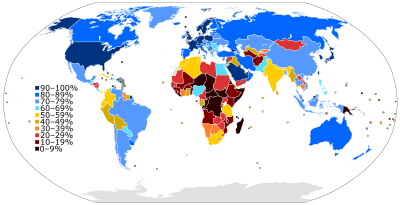The Internet as a Medium
(part C)
by
Charles Lamson
The Internet Audience
In the past few decades, we have seen a steady migration of people who used to spend time in front of the TV moving over to the computer. In 2005, Mainak Mazumdar, Nielson vice-president of product marketing and measurement science said, "It's not that people are abandoning TV for the Internet. Sometimes they do both. We only have 24 hours a day. . . . (That's) a finite amount of time to consume media." Of course, some TV networks also maintain popular Web sites, and this strategy is paying dividends in the digital age. For example, although overall TV use is down among Internet users, this same group watches more programming on cable networks such as Bravo and Comedy Central than do non-Internet users. This is doubtless due, at least in part, to the strong, feature-rich Web site that each channel maintains. (see www.comedycentral.com and www.bravo.com).
 |
Who Uses the Net
The percentage of the U.S. population able to access the Internet on a regular basis continues to climb. In 1997, only 50 million people were wired. This number had doubled by 2000 and has since doubled again. In 2006, more than 200 million people in the United States accessed the Internet each month. With nearly 290 million Internet users as of 2016, the United States is one of largest online markets worldwide. About 76.2 percent of the U.S. population accessed the internet as of 2016. (https://www.statista.com/topics/2237/internet-usage-in-the-united-states/).
As of June 2017, 51% of the world's population has internet access. In 2015, the International Telecommunication Union estimated about 3.2 billion people, or almost half of the world's population, would be online by the end of the year (https://en.wikipedia.org/wiki/Global_Internet_usage)

Internet users in 2015 as a percentage of a country's population
Source: International Telecommunications Union

These maps illustrate the growth in the percentage of individuals using the Internet from 1990-2014.
How People Use the Net
Some people believe that the first era of the World Wide Web has already passed, and that a new philosophy drives the activities of some companies. This philosophy has been dubbed Web 2.0 and represents the idea that the future of the Web is in companies that encourage user sharing and collaboration. Wikipedia, the popular online encyclopedia is often cited as a prime example of the new philosophy. Unlike most other encyclopedias, Wikipedia is not constructed from articles penned by authorities or experts. Instead, anyone can create an entry, which in turn can be edited by someone else. In this sense, the site represents the efforts of thousands of users, rather than hundreds of authorities. Other examples of this type of collaboration include eBay, del.icio.us, and Craigslist.
Types of Internet Advertising
Ads on the Internet can take a variety of forms, and as the Net matures, the number of forms continues to expand. Most advertising opportunities today can be classified as Web sites, banners, buttons, sponsorships, interstitials, search engine marketing, classified ads, and email ads. This post discusses each briefly.
Web sitesSome companies view their whole Web site as an ad. And in some ways it is. But in truth the Web site is more than an ad---it is an alternative "storefront," a location where customers, prospects and other stakeholders can come to find out more about the company, its products and services, and what it stands for.  Some companies use their Web site like an extended brochure to promote their goods and services; others act as information and entertainment publishers and try to create a cool place that people will visit often; still others treat their Web site as an online catalog store, conducting business right on the Net. Thus, except when used like a brochure, the Web site is really more than an ad; it is an "ad-dress." The NeoPets Web site, for example, is so full of activities that the average user spends between four and five hours per month at the site. As a result, Nielsen//NetRatings consistently ranks NeoPets as one of the top 10 "stickiest" sites on the Web. Advertisers like that a lot. Similarly, drug companies are now putting increased resources into their Web sites, turning them into giant "product information portals" that help doctors understand how the new medications work. The Internet offers high-quality visuals and an immense amount of information that no sales rep could ever offer. Banners and Buttons The basic form of Web advertising is the ad banner. A banner is a little billboard that spreads across the top or bottom of the Web page. When users click their mouse pointer on the banner it sends them to the advertiser's site or a buffer page. While banners are a common unit of Web advertising, the cost of a banner can range wildly---anywhere from free to thousands of dollars per month. Some standardization is taking place in the business, with most sites now charging, on a cost-per-thousand basis, anywhere from $0.25 to $100 CPM (cost per thousand on the basis of impression), depending on the number and type of visitors the site regularly receives. In 2003, in response to many agency requests to simplify the ad buying process, the Interactive Advertising Bureau (IAB), the Association of Web Publishers introduced the Universal Ad Package, a suite of sixteen standard ad sizes (including skyscrapers, rectangles and pop-ups, and banners and buttons) designed to improve the efficiency and ease of planning, buying, and creating online media. Similar to banners are buttons, small versions of the banner that often look like an icon and usually provide a link to an advertiser's landing page, a marketing tool that leads people into the purchasing or relationship-building process. Because buttons take up less space than banners, they also cost less. Today, a host of new software technologies have greatly enhanced the once-static banner and button ads. Full motion and animation, for example, are now commonplace. In fact, one of the greatest areas of recent growth has been rich-media advertising, which includes graphical animations and ads with audio and video elements that overlay the page or even float over the page. Many of the rich-media ads complement the standard banners endorsed by the IAB, as each of these can display 15-second animations. Some of the more common types of rich-media ads include animated banners, interstitials, Superstials, and rich mail. The interstitial is a catchall term for a variety of ads that play between pages on a Web site, popping up on the screen while the computer downloads a Web site, that the user has clicked on. All of their various formats tend to perform well in terms of click-through rates and brand recall---which is what the advertisers care about. The Superstitial is actually a trademark of Unicast, a strategic partner of Macromedia, which owns the Flash technology. The Superstitial makes use of a Unicast's proprietary "polite download" technology to push ads into a Web browser's cache only when the computer's bandwidth is idle; the ads then play from the cache when the user requests a new Web page. With polite download technology, the ad avoids tying up bandwidth when the user needs it. The standard Superstitial ad is quite large and plays for a long period of time (up to 20 seconds). Their size and playing time are similar to television ads, making them as rich as any experience available online. Rich mail on the other hand, allows graphics, video, and audio to be included in the email message. When you open up a rich email, your email client automatically calls up your internet connection and launches an HTML page in your email window. Email clients that are offline will invite you to click on the link when you have your Internet connection open again. If your email client does not support graphics, you will receive the email in text only. We can anticipate seeing more audio and animation integrated into these ads as improving technology accommodates them.  Sponsorships and Added-Value Packages A form of advertising on the Internet that is growing in popularity is the sponsorship of Web pages. Corporations sponsor entire sections of a publisher's Web page or sponsor single events for a limited period of time, usually calculated in months. In exchange for sponsorship support, companies are given extensive recognition on the site. Sometimes an added-value package is created by integrating the sponsor's brand with the publisher's content, as a sort of advertorial, or with banners and buttons on the page. Classified Ads Another growing area for Internet advertisers, is the plethora of classified ad Web sites, like CraigsList. Many of these offer free classified advertising opportunities because they are typically supported by ad banners of other advertisers. In style, the classifieds are very similar to what we are all familiar with from newspapers. You can search for homes, cars, computers, jobs, computer equipment, business opportunities, and so on. Moreover, the search can be narrowed to your city or expanded nationwide. Many of these sites are sponsored by the search engines themselves or by local newspapers around the country. Email Advertising Marketers have always known that direct-mail advertising is the most effective medium for generating inquiries and leads and for closing a sale. It has also been the most expensive medium on a cost-per-exposure basis. Now, thanks to the Internet, the power of direct-mail is increased even more, and the cost is reduced dramatically. A word of caution, though: It is important to differentiate responsible email advertising from spam, which is really just electronic junk mail. Spam generally refers to unsolicited, mass email advertising for a product or service that is sent by an unknown entity to a purchased mailing list or newsgroup. Spammers face the wrath of frustrated customers, tired of having their inboxes filled with unwanted emails. Since January 2004, spammers also face litigation under the CAN-SPAM Act (Controlling the Assault of Non-Solicited Pornography and Marketing). Legitimate email advertisers are required to (1) clearly mark the email as advertising, (2) provide a valid reply-to-email address, and (3) allow recipients to opt out of future mailings. The first lawsuits under the act were filed in April 2004, against two companies that had sent nearly a million emails advertising bogus diet patches and growth hormones. With this in mind, weary marketers are focusing their email efforts on customer retention and relationship management (CRM) rather than on prospecting. One of the honest trends on the Internet today is actually an application of email. Thanks to viral marketing, Amazon.com, Napster, eBay, Blue Mountain Arts, and Hotmail all made it big on the Web, reaching unexpected heights in short time spans, most with surprising low marketing budgets. Viral marketing is the Internet version of word-of-mouth advertising via email. The term was coined in 1997 by Steven Jurvetson and his partners at the venture capital firm Draper Fisher Jurvetson. They were describing free email provider Hotmail's incredible growth to 12 million users in just 18 months through the use of a little message at the bottom of every email. The message invited recipients to sign up for their own free Hotmail account.  Since that time, many other marketers have come up with ways to induce their satisfied customers to recommend their product or service to friends and family members. One of the keys to viral marketing success is to present an offer with real perceived value---one that people will want to share with one another. Audible, a Web site featuring digital audio books, for example, uses a referral program whereby members are rewarded with free books each time someone they refer to the site signs up and becomes a member. Since members enjoy the site so much, it is natural that they would want to share the pleasure with their friends and families.
*SOURCE: CONTEMPORARY ADVERTISING 11TH ED., 2008, WILLIAM F. ARENS, MICHAEL F. WEIGOLD, CHRISTIAN ARENS, PGS. 549-559*
END
|

No comments:
Post a Comment